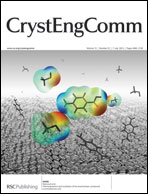Six novel hybrids based on Wells–Dawson polyoxometalates, [{Cu0.5(imi)(O0.5H)Cu0.5(imi)2}2{Cu0.5(imi)}2(P2W18O62)]·5H2O (1), (Himi)2[{Mn(2,2′-bpy)2}2(P2W18O62)]·H2O (2), (Himi)2[{Cu(2,2′-bpy)2}2(P2W18O62)]·H2O (3), [Cu(phen)2Cl]2[{Cu(phen)(H2O)(gly)Cu(phen)}(P2W18O62)]·3H2O (4) [Mn(phen)3][{Mn(phen)2(H2O)}2(P2W18O62)]·3.5H2O (5), and (H2phen)[Mn(phen)3][{Mn(phen)(H2O)3}(P2W18O62)]·3.5H2O (6), (imi = imidazole, bpy = bipyridine, phen = 1,10-phenanthroline, gly = glycine), have been synthesized under hydrothermal conditions and structurally characterized by elemental analysis, IR, UV, TG, and single-crystal X-ray diffraction. Compound 1 represents an unprecedented 2D metal–organic layer based on hexad-supported {P2W18O62}6− (abbreviated to P2W18) anions and Cu–imi complexes linker. Compounds 2 and 3 exhibit similar 1-D chains. Compound 4 displays a 1-D chain built by {P2W18} clusters and an unusual binuclear complex {Cu(phen)(H2O)(gly)Cu(phen)} linker. Compounds 5 and 6 are bi-supported and mono-supported 0-D clusters. All the clusters are further packed into various 3-D assemblies via strong hydrogen-bonding and supramolecular interactions. Furthermore, electrochemical behavior and magnetic properties of 1–6 have been investigated in detail.


 Please wait while we load your content...
Please wait while we load your content...